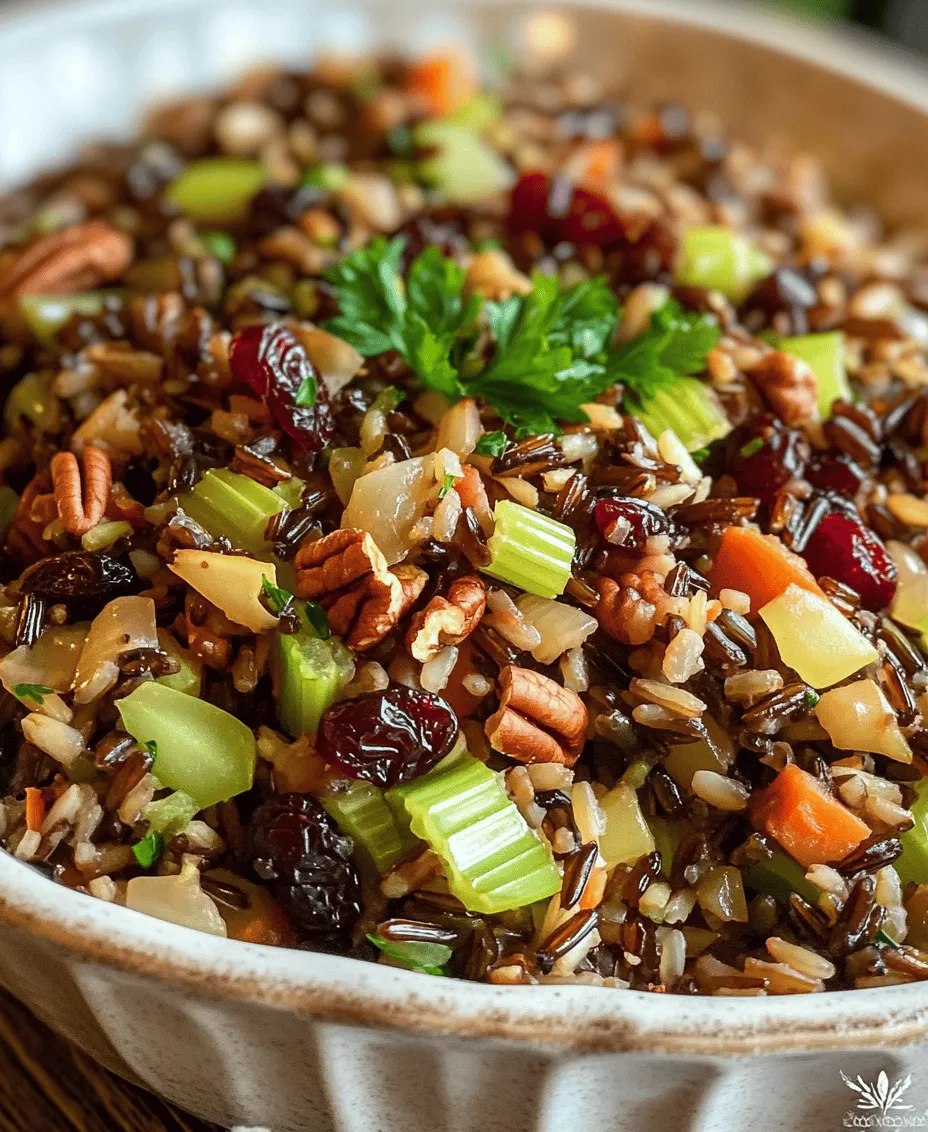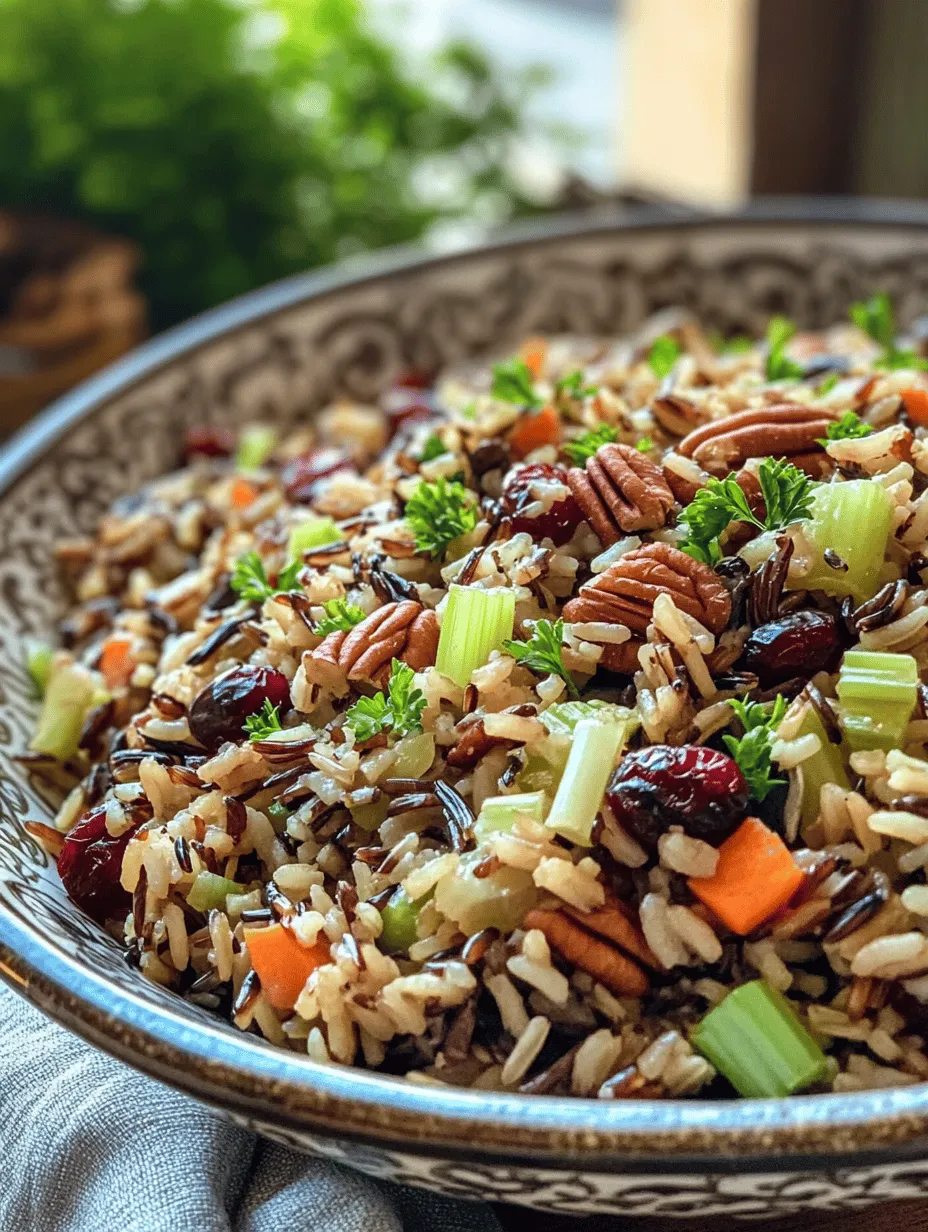Wild Rice Pilaf with Cranberries and Pecans is a delightful dish that embodies the essence of comfort food while incorporating a medley of nutritious ingredients. This wholesome recipe is perfect for festive gatherings, family dinners, or as a hearty side dish to accompany your favorite protein. With its nutty flavor from wild rice, the sweetness of cranberries, and the crunch of pecans, this pilaf is not only visually appealing but also packed with flavor and texture.
As we dive into this culinary experience, we will explore the nutritional benefits of wild rice, the cooking techniques that bring out the best in this dish, and various serving suggestions that can elevate your dining experience. Whether you are a seasoned chef or a novice cook, this pilaf recipe promises to be a satisfying addition to your repertoire.
Understanding Wild Rice
To truly appreciate this dish, it’s essential to understand the unique qualities of wild rice. Unlike traditional rice varieties, wild rice is an aquatic grass native to North America, known for its distinctive long grains and nutty flavor.
Origin and History of Wild Rice
Wild rice has a rich history, deeply intertwined with the cultures of Native American tribes in the Great Lakes region. Harvested from natural lakes and rivers, it was a staple food for these communities, valued not only for its taste but also for its nutritional benefits. Today, wild rice is cultivated in various regions across the United States, particularly in Minnesota and Wisconsin, where its traditional harvesting methods continue to be celebrated.
Nutritional Profile of Wild Rice
Wild rice is often touted as a superfood due to its impressive nutritional profile. It is a whole grain that is high in protein, fiber, and essential nutrients. A serving of cooked wild rice contains about 166 calories, making it a low-calorie option for those looking to maintain a healthy diet. It is rich in antioxidants, vitamins, and minerals such as magnesium, phosphorus, and B vitamins. Furthermore, wild rice is gluten-free, making it an excellent choice for those with gluten sensitivities.
Differences Between Wild Rice and Other Rice Varieties
One of the most notable differences between wild rice and other rice varieties is its texture and flavor. While white and brown rice can be soft and chewy, wild rice has a firmer, more al dente texture, which adds a unique mouthfeel to dishes. Additionally, wild rice possesses a distinct nutty flavor that enhances any recipe, making it a versatile ingredient in various cuisines. Unlike traditional rice, wild rice also has a higher protein content, making it a great choice for those looking to incorporate more plant-based protein into their meals.
Ingredients Breakdown
Now that we’ve established the importance of wild rice, let’s take a closer look at the ingredients that will make this Wild Rice Pilaf with Cranberries and Pecans a standout dish.
Wild Rice: The Star of the Dish
As the primary ingredient, wild rice serves as the foundation of this pilaf. Its earthy flavor and chewy texture provide a perfect backdrop for the other ingredients. When selecting wild rice, opt for whole grain varieties for the best flavor and texture.
Vegetable Broth vs. Chicken Broth: Flavor Variations
For cooking the wild rice, you can use either vegetable broth or chicken broth, depending on your dietary preferences. Vegetable broth will keep the dish vegetarian and enhance the flavors of the vegetables, while chicken broth will add a rich, savory depth. Both options work beautifully, allowing you to customize the dish to your taste.
Vegetables: Onions, Celery, and Carrots for Depth
A blend of aromatic vegetables like onions, celery, and carrots adds layers of flavor to the pilaf. Onions contribute sweetness and depth, while celery adds a refreshing crunch. Carrots bring a hint of sweetness and a pop of color, making the dish visually appealing.
Herbs and Spices: Thyme, Rosemary, Salt, and Pepper for Seasoning
Herbs and spices play a crucial role in elevating the flavors of the pilaf. Fresh thyme and rosemary add fragrant notes, while salt and pepper enhance the overall taste. You can adjust the seasoning to your liking, ensuring that the pilaf is perfectly balanced.
Dried Cranberries: Adding Sweetness and Color
Dried cranberries provide a delightful burst of sweetness and a beautiful contrast to the earthy flavors of the wild rice. Their vibrant red color adds visual appeal, making the dish not only tasty but also attractive on the plate.
Pecans: Providing Crunch and Healthy Fats
Pecans add a satisfying crunch and a rich, buttery flavor that complements the other ingredients beautifully. They are also a great source of healthy fats, making this dish not only delicious but nutritious as well. Toasting the pecans before adding them to the pilaf enhances their flavor, making them even more irresistible.
Olive Oil: The Base for Sautéing
Olive oil is the go-to fat for sautéing the vegetables and toasting the nuts. Its light flavor allows the other ingredients to shine while providing healthy monounsaturated fats that are beneficial for heart health.
Fresh Parsley: A Finishing Touch for Presentation
Finally, fresh parsley adds a burst of color and freshness to the dish. Chopped and sprinkled on top just before serving, it brightens the overall presentation and provides a hint of herbal flavor that rounds out the dish.
Preparation Steps
Now that we have a clear understanding of the ingredients, let’s delve into the preparation steps for creating this delicious Wild Rice Pilaf with Cranberries and Pecans.
Rinsing and Cooking Wild Rice: Techniques for the Perfect Texture
Start by rinsing the wild rice thoroughly under cold water. This process helps remove any debris and excess starch, ensuring a light and fluffy texture once cooked. After rinsing, combine the wild rice with your choice of vegetable or chicken broth in a saucepan. The general ratio is 1 cup of wild rice to 3 cups of broth, but be sure to check the package instructions for the specific cooking times and ratios, as they can vary.
Bring the broth to a boil, then reduce the heat to low, cover the saucepan, and let it simmer. Cook the wild rice for 40-60 minutes, or until the grains are tender and have split open, revealing their fluffy inner texture. Keep an eye on the pot and add more liquid if necessary to prevent the rice from drying out. Once cooked, remove the saucepan from heat and let it sit, covered, for about 10 minutes. This resting period allows the rice to absorb any remaining liquid, resulting in perfectly cooked wild rice.
While the wild rice is cooking, you can prepare the sautéed vegetables and toasted pecans, which will enhance the overall flavor and texture of the pilaf.
Sautéing the Vegetables
In a large skillet, heat a couple of tablespoons of olive oil over medium heat. Once the oil is hot, add the chopped onions, celery, and carrots. Sauté the vegetables for about 5-7 minutes, or until they are softened and the onions are translucent. The aroma of sautéing vegetables will fill your kitchen, creating an inviting atmosphere that sets the stage for this delicious dish.
Toasting the Pecans
In a separate small skillet, toast the pecans over medium heat for about 5 minutes, stirring frequently to prevent burning. Toasting the nuts brings out their natural oils, enhancing their flavor and making them even more delightful when mixed into the pilaf.
Once the wild rice is cooked and the vegetables are sautéed, you can combine all the elements to create the perfect Wild Rice Pilaf with Cranberries and Pecans. The next steps will guide you through this final assembly, where the magic truly happens.
In the following sections, we will cover the final preparation steps, tips for best results, and common questions that may arise while making this recipe. Stay tuned for a comprehensive guide that will ensure your pilaf turns out beautifully every time.

Sautéing Vegetables: Tips for Achieving the Right Doneness
Sautéing vegetables is a crucial step in preparing Wild Rice Pilaf with Cranberries and Pecans, as it enhances the dish’s flavor and texture. To ensure your vegetables achieve the perfect doneness, consider the following tips:
1. Choose the Right Oil: Using a neutral oil with a high smoke point, like canola or grapeseed oil, allows for even cooking without imparting strong flavors. Alternatively, olive oil can lend a pleasant taste when used at medium heat.
2. Cut Uniformly: Chop your vegetables into uniform sizes to ensure they cook evenly. For this recipe, a mix of diced onions, bell peppers, and celery provides a delightful flavor base.
3. Don’t Overcrowd the Pan: If you add too many vegetables at once, they will steam rather than sauté. Work in batches if necessary, allowing each piece to brown properly for a richer flavor profile.
4. Monitor Heat Levels: Start with medium-high heat to sear the vegetables, then reduce to medium to avoid burning. Stir occasionally to achieve even browning and tenderness.
5. Know When to Stop: Vegetables should be tender but still vibrant in color. Aim for a slight caramelization, which adds sweetness and depth, but avoid overcooking, as they will continue to soften when combined with the rice.
Combining Ingredients: Ensuring a Harmonious Blend
Once your vegetables are perfectly sautéed, it’s time to combine them with the wild rice and other ingredients. Here are key steps to ensure a harmonious blend:
1. Add the Wild Rice: Once your vegetables are cooked to your satisfaction, add the pre-cooked wild rice to the pan. Stir gently to combine, allowing the vegetables to coat each grain with flavor.
2. Incorporate Cranberries and Pecans: Fold in the dried cranberries and toasted pecans in this step. The cranberries bring a sweet-tart flavor that beautifully contrasts with the earthy wild rice and the richness of the pecans.
3. Use Broth for Flavor: To elevate the dish, pour in vegetable or chicken broth, ensuring that the rice absorbs the flavors. This step also helps to prevent the pilaf from becoming dry, promoting a moist and delicious final dish.
4. Stir Thoroughly: Mix the ingredients well to distribute flavors evenly. Let the mixture cook for an additional 5-10 minutes, allowing the wild rice to absorb the liquids and the cranberries to plump up.
Adjusting Seasoning: Personalizing the Flavor Profile
Seasoning is where you can truly make this dish your own. Here are ways to adjust the seasoning for a personalized flavor profile:
1. Start with the Basics: Begin with salt and pepper to enhance the natural flavors of the ingredients. Taste as you go, adding small amounts until the desired flavor is achieved.
2. Experiment with Herbs: Fresh herbs like thyme, parsley, or rosemary can elevate the pilaf. Dried herbs are also effective; just remember to use them sparingly since they are more concentrated.
3. Add a Touch of Acidity: A splash of lemon juice or a dash of balsamic vinegar can brighten the flavors of the dish, cutting through the richness of the pecans and the sweetness of the cranberries.
4. Consider Spice Levels: For those who enjoy a bit of heat, a pinch of red pepper flakes or a dash of cayenne pepper can add an exciting kick without overpowering the dish.
Nutritional Benefits
Wild Rice Pilaf with Cranberries and Pecans is not only a flavorful dish but also packed with nutritional benefits:
Wild Rice: A Source of Antioxidants and Fiber
Wild rice is an excellent source of dietary fiber, which aids digestion and promotes a feeling of fullness. This whole grain is also rich in antioxidants, helping to fight inflammation and protect against chronic diseases. Its unique nutty flavor and chewy texture enhance the overall eating experience.
Nutritional Benefits of Cranberries
Cranberries are not only delicious but also packed with vitamins and minerals. They are particularly high in vitamin C, which supports the immune system, and antioxidants that promote heart health. Cranberries also have properties that may help prevent urinary tract infections, making them a beneficial addition to your diet.
The Role of Pecans in Heart Health
Pecans are a heart-healthy nut, rich in monounsaturated fats that can lower bad cholesterol levels. They also provide essential nutrients, including magnesium, zinc, and vitamin E, contributing to overall health. The healthy fats in pecans help keep you feeling satisfied and can even aid in weight management.
Overall Health Benefits of This Plant-Based Dish
This pilaf is a well-rounded dish that offers a balance of carbohydrates, healthy fats, and plant-based protein, making it suitable for various dietary needs. With its blend of whole grains, fruits, and nuts, it supports energy levels while providing essential nutrients. The dish is naturally gluten-free and can easily be adapted for vegan diets, making it a versatile option for any meal.
Serving Suggestions
Wild Rice Pilaf with Cranberries and Pecans can be served in various ways, making it a perfect addition to any table:
Ideal Main Dishes to Accompany the Pilaf
This pilaf pairs beautifully with several main dishes. Consider serving it alongside roasted chicken or turkey for a classic pairing, or try it with grilled vegetables for a hearty vegetarian option. If you’re looking for a comforting choice, serve it next to a creamy mushroom sauce or a savory stuffing.
Creative Plating Techniques for a Festive Presentation
For a visually stunning presentation, serve the pilaf in a hollowed-out squash or pumpkin. This not only adds an autumnal touch but also enhances the meal’s overall aesthetic. Alternatively, layer the pilaf in a shallow bowl, garnishing it with fresh herbs or a sprinkle of additional cranberries and pecans for texture and color.
Storing Leftovers: Best Practices for Freshness
If you have leftovers, they can be stored in an airtight container in the refrigerator for up to five days. For longer storage, consider freezing the pilaf. Allow it to cool completely before transferring it to a freezer-safe container, where it can last up to three months. To reheat, simply thaw in the refrigerator overnight and warm it in a pan with a splash of broth or water to restore moisture.
Variations and Customizations
Wild Rice Pilaf with Cranberries and Pecans is a versatile recipe that can easily be adapted to meet your dietary preferences:
Substituting Ingredients for Dietary Restrictions
If you have nut allergies, you can replace pecans with sunflower seeds or pumpkin seeds for a similar crunch. If you prefer a gluten-free option, ensure that you use certified gluten-free broth and verify the ingredients of any packaged items.
Adding Seasonal Vegetables for Variety
Feel free to get creative with vegetables based on the season. Adding diced carrots, bell peppers, or even sautéed mushrooms can introduce new flavors and textures. Root vegetables like sweet potatoes can also provide a sweet contrast to the savory elements of the pilaf.
Incorporating Proteins for a More Filling Meal
For a more substantial meal, consider adding protein sources such as cooked chicken, turkey, or even plant-based proteins like chickpeas or lentils. These additions not only boost the dish’s nutritional value but also make it a complete meal.
Conclusion
Wild Rice Pilaf with Cranberries and Pecans is a versatile and nutritious dish that can elevate any meal. This recipe highlights the rich flavors of its ingredients and serves as a testament to the comfort and joy that home-cooked meals can bring. With its ease of preparation and adaptability, this pilaf is sure to become a favorite in your culinary repertoire. Embrace the warmth of this dish and enjoy the delightful combination of textures and tastes it offers. Whether served as a side or a main dish, this pilaf promises to satisfy and nourish, making it a perfect choice for any occasion.

